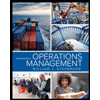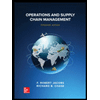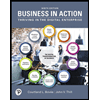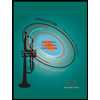
Practical Management Science
6th Edition
ISBN: 9781337406659
Author: WINSTON, Wayne L.
Publisher: Cengage,
expand_more
expand_more
format_list_bulleted
Concept explainers
Question
1. A multiple channel queuing system with a Poisson arrival rate, and an exponential service time distribution has an average arrival rate of 2.5 customers per hour and an average service time of eighty minutes per customer. A queuing system is described as unstable or overloaded if its utilization rate is greater than, or equal to one. For the system just described, what is the minimum number of servers required to retain stability i.e., to avoid overloading?
A. 2
B. 3
C. 1
D. 4
Expert Solution
This question has been solved!
Explore an expertly crafted, step-by-step solution for a thorough understanding of key concepts.
This is a popular solution
Trending nowThis is a popular solution!
Step by stepSolved in 2 steps

Follow-up Questions
Read through expert solutions to related follow-up questions below.
Follow-up Question
The question states 80 minutes per customer but the solution uses 8 minutes per customer
Solution
by Bartleby Expert
Follow-up Questions
Read through expert solutions to related follow-up questions below.
Follow-up Question
The question states 80 minutes per customer but the solution uses 8 minutes per customer
Solution
by Bartleby Expert
Knowledge Booster
Learn more about
Need a deep-dive on the concept behind this application? Look no further. Learn more about this topic, operations-management and related others by exploring similar questions and additional content below.Similar questions
- True or False? In a waiting line system, the average system time Wₛ must be longer than the average waiting time Wqarrow_forwardPicturearrow_forward1. The DMV Licensing office has a single line for customers waiting for the next available clerk. There are two clerks who work at the same rate. On average customers arrive every 8 minutes and the average service rate is 5 per hour for each of the two clerks. The arrival rate of customers follows a Poisson distribution, while the service time follows an exponential distribution. a.) What is the service rate? (please include units) b.) What is the arrival rate? (please include units)arrow_forward
- Last National Bank is concerned about the level of service at its single drive-in window. A study of customer arrivals during the window’s busy period revealed that, on average, 20 customers per hour arrive, with a Poisson distribution, and they are given FCFS service, requiring an average of 2 minutes, with service times having a negative exponential distribution. a. What is the expected number of customers waiting in queue? b. If Last National were using an automated teller machine with a constant service time of 2 minutes, what would be the expected number of drive-in customers in the system? c. There is space in the drive for three cars (including the one being served). What is the probability of traffic on the street being blocked by cars waiting to turn into the bank driveway? d. Last National is considering adding tellers at the current drive-in facility. It has decided on $5 per hour as the imputed cost of customer waiting time in the system. The hourly cost of a teller is $10.…arrow_forward1.)The arrival rate is the rate of arrivals to the service facility all of these rate items arrive at the server after being in the queue time between arrivals to the service facility 2.) what is "queue discipline"?arrow_forwardPlease do not give solution in image format thanku Average Arrival Rate (Ri) 20 Customers/Hr Arrival Standard Deviation is 2 customers/hr Average Processing Time 12 minutes Process Time Standard Deviation 3 minutes 5 Servers 1) What is Server Utilization? 2) Average Queue Length?arrow_forward
- 4.) The DMV Licensing office has a single line for customers waiting for the next available clerk. There are two clerks who work at the same rate. On average customers arrive every 8 minutes and the average service rate is 5 per hour for each of the two clerks. The arrival rate of customers follows a Poisson distribution, while the service time follows an exponential distribution. a.) What percentage of the total available service time is being used? b.) Due to Covid restrictions, only two customers are allowed in the office at the same time. What percent of the time will there be customers waiting outside?arrow_forwardPlease do not give solution in image format thanku 1. A single server queuing system with a Poisson arrival rate and exponential service time has an average arrival rate of 13 customers per hour and an average service rate of 20 customers per hour. The average length of time customers will spend in the system is: Select one: a. 0.09286 minutes b. 0.1429 minutes c. 8.571 minutes d. 5.571 minutes 2. A single server queuing system with a Poisson arrival rate and exponential service time has an average arrival rate of 10 customers per hour and an average service rate of 13 customers per hour. The probability of 3 customers in the system is : Select one: a.0.895 b.0.5448 c.0.2308 d.0.105arrow_forward3 The M/M/1 Queue During peak time, customers arrive at a bank teller window (with a single teller) at a rate of 23 per hour, where the teller can serve 25 per hour. This problem will allow you to investigate (via a simple extension of the mean queue size formula) the effect of highly-variable service times on our familiar queuing metrics. The diagram below stylizes the queuing system: Waiting Service Calculate the marginal probability P (T > oT). a. O b. 0.25 O c. 0.63 O d. 0.75 Calculate the mean time a customer spends at the bank (waiting time plus service time) in minutes. O a. 30 minutes O b. 27.6 minutes O c. 2.4 minutes O d. 7 minutesarrow_forward
arrow_back_ios
arrow_forward_ios
Recommended textbooks for you
 Practical Management ScienceOperations ManagementISBN:9781337406659Author:WINSTON, Wayne L.Publisher:Cengage,
Practical Management ScienceOperations ManagementISBN:9781337406659Author:WINSTON, Wayne L.Publisher:Cengage, Operations ManagementOperations ManagementISBN:9781259667473Author:William J StevensonPublisher:McGraw-Hill Education
Operations ManagementOperations ManagementISBN:9781259667473Author:William J StevensonPublisher:McGraw-Hill Education Operations and Supply Chain Management (Mcgraw-hi...Operations ManagementISBN:9781259666100Author:F. Robert Jacobs, Richard B ChasePublisher:McGraw-Hill Education
Operations and Supply Chain Management (Mcgraw-hi...Operations ManagementISBN:9781259666100Author:F. Robert Jacobs, Richard B ChasePublisher:McGraw-Hill Education
 Purchasing and Supply Chain ManagementOperations ManagementISBN:9781285869681Author:Robert M. Monczka, Robert B. Handfield, Larry C. Giunipero, James L. PattersonPublisher:Cengage Learning
Purchasing and Supply Chain ManagementOperations ManagementISBN:9781285869681Author:Robert M. Monczka, Robert B. Handfield, Larry C. Giunipero, James L. PattersonPublisher:Cengage Learning Production and Operations Analysis, Seventh Editi...Operations ManagementISBN:9781478623069Author:Steven Nahmias, Tava Lennon OlsenPublisher:Waveland Press, Inc.
Production and Operations Analysis, Seventh Editi...Operations ManagementISBN:9781478623069Author:Steven Nahmias, Tava Lennon OlsenPublisher:Waveland Press, Inc.

Practical Management Science
Operations Management
ISBN:9781337406659
Author:WINSTON, Wayne L.
Publisher:Cengage,

Operations Management
Operations Management
ISBN:9781259667473
Author:William J Stevenson
Publisher:McGraw-Hill Education

Operations and Supply Chain Management (Mcgraw-hi...
Operations Management
ISBN:9781259666100
Author:F. Robert Jacobs, Richard B Chase
Publisher:McGraw-Hill Education


Purchasing and Supply Chain Management
Operations Management
ISBN:9781285869681
Author:Robert M. Monczka, Robert B. Handfield, Larry C. Giunipero, James L. Patterson
Publisher:Cengage Learning

Production and Operations Analysis, Seventh Editi...
Operations Management
ISBN:9781478623069
Author:Steven Nahmias, Tava Lennon Olsen
Publisher:Waveland Press, Inc.